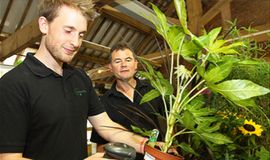Method:
• Using a sharp boning knife, remove any excess fat & sinew from the outside of the joint. Then, from the side of the joint with the largest surface, begin to cut around the bone, staying as close to it as possible taking care not to waste any of the meat.
• Once at the ball & socket joint, grip both ends of the leg & snap the bone firmly to release the grip on the socket. Cut around the socket to release fibres still holding the bone in place, then remove the bone and place to one side for making the sauce.
• Leave the rest of the bone in place. As the lamb roasts, the meat will recede, leaving the bone showing at the end of the leg to enhance the presentation of the cooked joint.
• Using the butcher’s string, tie a piece around the leg, starting at the end and pull tight. Repeat this process every inch down the joint until you reach the end.
• Place the joint and the bone that you removed on a baking tray, season, stud with garlic, rosemary and achovies. For pink lamb, roast for 1 hour 10 mins and rest, or for well done lamb roast for 1 hour 30 mins. Regularly baste during roasting until a dark crust has formed on the outside and the inside temperature is at about 60c. Then leave to rest.
• Use the roasting juices for your sauce by deglazing the pan with wine or port and a little stock. Scratch all the roasted pieces off the bottom of the tray and pass the remaining stock through a sieve into a pan. Reduce by half and thicken by emulsifying one or two knobs of butter whilst the stock is boiling.
• Serve with seasonal vegetables and enjoy the perfect roast!
Top Tips…
• Fancy a different take on the traditional roast? – Try stuffing your leg of lamb with Welsh Pantysgawn goats cheese, spinach & pine nuts.
• For a Moroccan twist, try rubbing the lamb with ras el hanout before roasting and serving with pomegranate & mint couscous.






